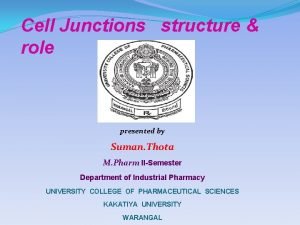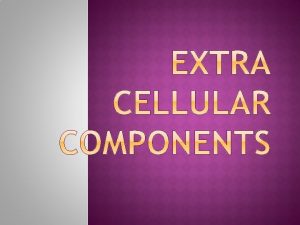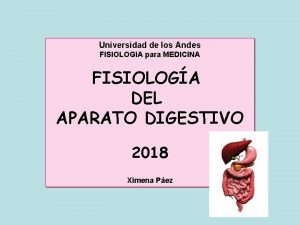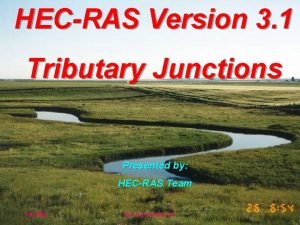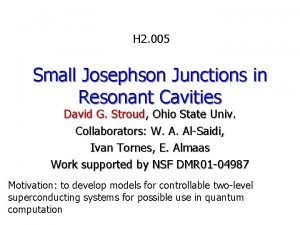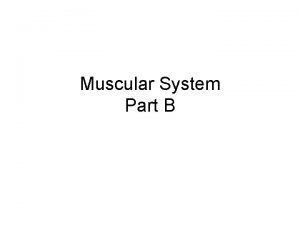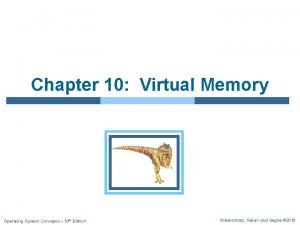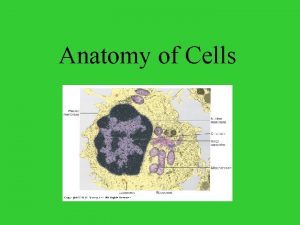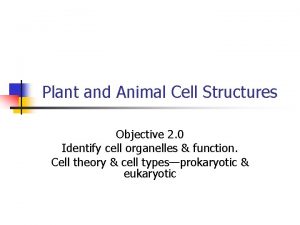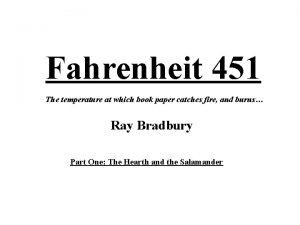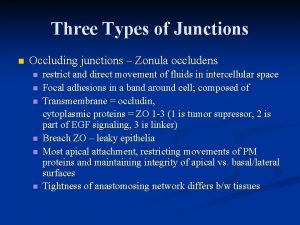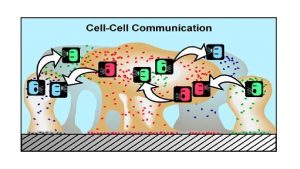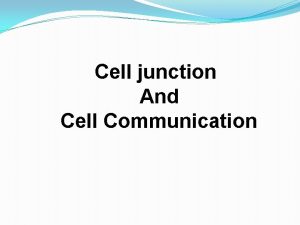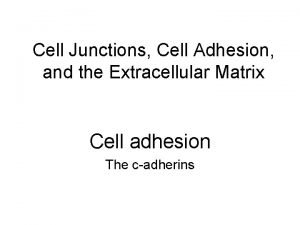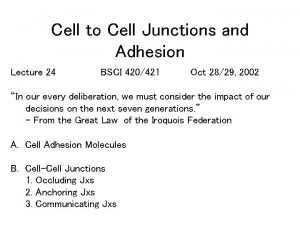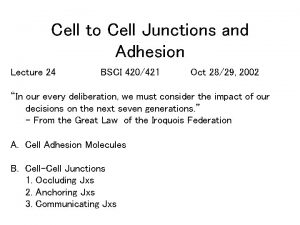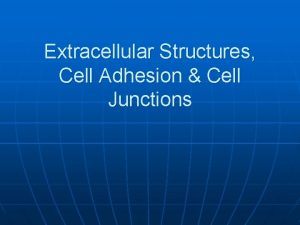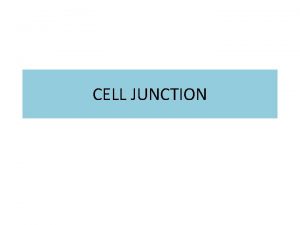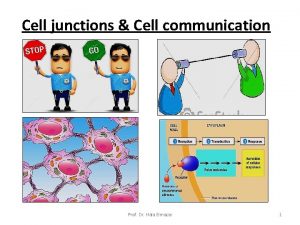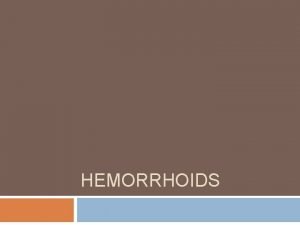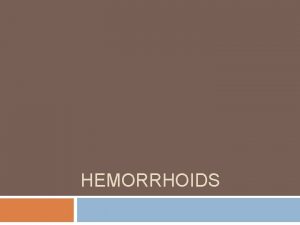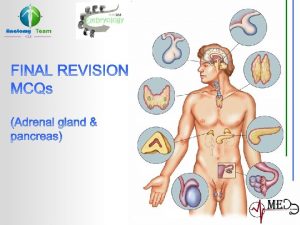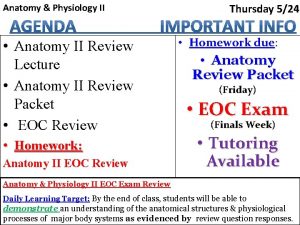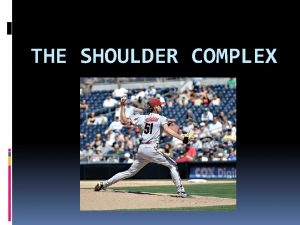Chapter 3 Cell Anatomy and Cell Junctions Pages
























- Slides: 24

Chapter 3: Cell Anatomy and Cell Junctions Pages 62 -75 © 2015 Pearson Education, Inc.

Anatomy and Physiology of Cells � It is important to know the organelles within the cell and to understand the general functions of each ◦ Organelles > cell ◦ Organs > system ◦ Organ systems > human body © 2015 Pearson Education, Inc.

Summary of Organelles and their Functions Nucleus = control center; houses DNA � Plasma Membrane = selective; boundary � Ribosomes = site of protein synthesis � Mitochondria = site of cellular respiration � Endoplasmic Reticulum = transportation network � ◦ Rough = finalizing protein synthesis - folding ◦ Smooth = fat metabolism and detoxing Golgi Bodies =protein packaging; become vesicles � Vesicles = move products via endocytosis/exocytosis � Lysosomes = garbage crew � Peroxisomes = detoxification/neutralizers � Cytoskeleton = structural organelle � Centrioles =direct cell division via mitotic spindle �

Figure 3. 4 Structure of the generalized cell. Smooth endoplasmic reticulum Chromatin Nucleolus Nuclear envelope Nucleus Plasma membrane Lysosome Mitochondrion Rough endoplasmic reticulum Centrioles Ribosomes Golgi apparatus Peroxisome Secretion being released from cell by exocytosis

“How do cells stick together? ” � Plasma Membrane Junctions ◦ Cells are bound together in three ways: 1. Glycoproteins act as an adhesive or cellular glue 2. Wavy contours of the membranes of adjacent cells fit together in a tongue-and-groove fashion 3. Special membrane junctions are formed, which vary structurally depending on their roles 1. 3 different junctions © 2015 Pearson Education, Inc.

Figure 3. 2 Structure of the plasma membrane. Extracellular fluid (watery environment) Glycoprotein Glycolipid Cholesterol Sugar group Polar heads of phospholipid molecules Bimolecular lipid layer containing proteins Nonpolar tails of phospholipid molecules Channel Proteins Filaments of cytoskeleton Cytoplasm (watery environment)

Figure 3. 3 Cell junctions. Tight (impermeable) junction Microvilli Desmosome (anchoring junction) Plasma membranes of adjacent cells Connexon Gap Underlying Extracellular basement space between (communicating) junction membrane cells

TIGHT JUNCTIONS � Tight junctions ◦ Impermeable junctions made up of the plasma membrane ◦ Bind cells together into leakproof sheets ◦ Prevent substances from passing through extracellular space between cells © 2015 Pearson Education, Inc.

DESMOSOMES � Desmosomes ◦ Anchoring junctions that prevent cells from being pulled as a result of mechanical stress ◦ Created by “buttonlike” thickenings of adjacent plasma membranes �kind of like the rivets in the pockets of your jeansthey keep the material together © 2015 Pearson Education, Inc.

GAP JUNCTIONS � Gap junctions ◦ allow direct diffusion of ions and small molecules between adjacent cells ◦ Hollow cylinders of proteins (connexons) function like tunnels to send messages �Molecules can travel directly from one cell to the next through these channels © 2015 Pearson Education, Inc.

Figure 3. 3 Cell junctions. Tight (impermeable) junction Microvilli Desmosome (anchoring junction) Plasma membranes of adjacent cells Connexon Gap Underlying Extracellular basement space between (communicating) junction membrane cells

Exocytosis/Endocytosis review � Active Transport of bulk materials � Endocytosis: ◦ Plasma membrane engulfs product from extracellular space to bring into cell ◦ Becomes travelling vesicle inside cell � Exocytosis: ◦ Vesicle from inside the cell fuses with plasma membrane to dump contents outside of cell

Figure 3. 12 Exocytosis. Extracellular Plasma membrane fluid SNARE (t-SNARE) Secretory vesicle 1 The membranebound vesicle Vesicle migrates to the SNARE (v-SNARE) plasma membrane. Molecule to be secreted Cytoplasm Fusion pore formed Fused SNAREs 2 There, v-SNAREs bind with t-SNAREs, the vesicle and plasma membrane fuse, and a pore opens up. 3 Vesicle contents are released to the cell exterior. (a) The process of exocytosis (b) Electron micrograph of a secretory vesicle in exocytosis (190, 000×)

Figure 3. 13 a Events and types of endocytosis. Extracellular fluid Cytosol Vesicle 1 Vesicle fusing with lysosome for digestion Plasma membrane Lysosome Release of contents to cytosol 2 Transport to plasma membrane and exocytosis of vesicle contents Detached vesicle Ingested substance Pit (a) 3 Membranes and receptors (if present) recycled to plasma membrane

Cell Extensions � Cilia: whiplike extensions ◦ Propels substances along passageways �Found in respiratory passageways, uterine tubes, kidneys, inner ear � Flagella: longer whiplike extensions ◦ Propels the cell �The sperm is the only flagellated cell in the human � Microvilli: extensions of cell membrane ◦ Increases cell surface area (often for absorption) �Found along entire small intestine; large numbers along the proximal convoluted tubule in the nephron

Figure 14. 7 Structural modifications of the small intestine. Blood vessels serving the small intestine Muscle layers Villi Microvilli (brush border) Lumen Circular folds (plicae circulares) Absorptive cells Lacteal (a) Small intestine (c) Absorptive cells Villus Blood capillaries Lymphoid tissue Intestinal crypt Muscularis mucosae Venule Lymphatic vessel Submucosa (b) Villi

Figure 3. 8 g Cell diversity. Flagellum Nucleus Sperm (g) Cell of reproduction

Cell Diversity � Cells can vary in structure and function � Variations include: ◦ Modified shape ◦ More of a particular organelle ◦ Modified organelles

Specialized Function of cells � Cells are classified based on their structure and function � This is known as Histology ◦ the study of the structure of cells and their formation into tissues and organs � An Histologist can identify abnormalities in tissues obtained from cultures/biopsies

Body Tissues � Epithelial ◦ Secrete and aborb � Connective ◦ Hold structures together, store nutrients � Muscular ◦ Movement � Nervous ◦ communication

Figure 3. 8 b Cell diversity. EPITHELIAL Epithelial cells Nucleus Intermediate filaments

Figure 3. 8 c Cell diversity. MUSCULAR Skeletal muscle cell Contractile filaments Nuclei Smooth muscle cells

Figure 3. 8 a Cell diversity. CONNECTIVE Fibroblasts Rough ER and Golgi apparatus No organelles Nucleus Erythrocytes

Figure 3. 8 f Cell diversity. NERVOUS Processes Rough ER Nerve cell Nucleus
 Printed pages vs web pages
Printed pages vs web pages Desmosome
Desmosome Gupta definition
Gupta definition Gap junctions vs plasmodesmata
Gap junctions vs plasmodesmata Microfold
Microfold Junction hec ras
Junction hec ras Smooth muscle contraction
Smooth muscle contraction Josephson junctions
Josephson junctions Asynchronous recruitment of motor units
Asynchronous recruitment of motor units The scientist mathias schleiden studied _______ in ______.
The scientist mathias schleiden studied _______ in ______. Pages 294 and 295
Pages 294 and 295 A process is busy swapping pages in and out. *
A process is busy swapping pages in and out. * Smooth endoplasmic
Smooth endoplasmic Typical cell
Typical cell Endoplasmic reticulum found in plants or animals
Endoplasmic reticulum found in plants or animals Cell anatomy
Cell anatomy Eyeline yearbook example
Eyeline yearbook example A collection of web pages.
A collection of web pages. The lorax edpuzzle answers
The lorax edpuzzle answers Hijos de pagés llergo
Hijos de pagés llergo What is jsp file
What is jsp file How many pages are in fahrenheit 451
How many pages are in fahrenheit 451 Fahrenheit 451 pg 45-65
Fahrenheit 451 pg 45-65 What did beatty discover when he hit montag
What did beatty discover when he hit montag Whats double spaced
Whats double spaced

